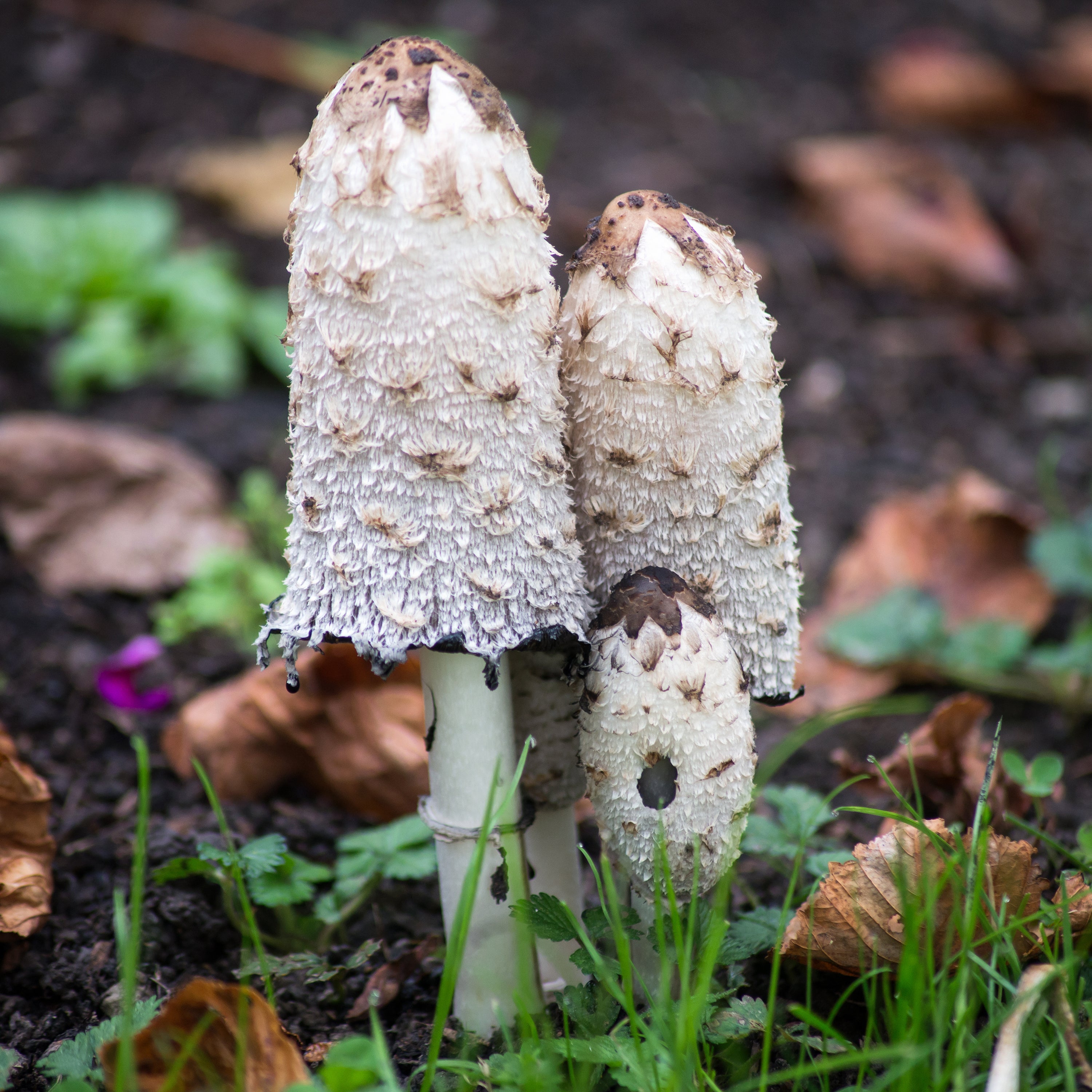THE LIVING SOIL: FUNGI
Soil Fungi
By Elaine R. Ingham
Fungi are microscopic cells that usually grow as long threads or strands called hyphae, which push their way between soil particles, roots, and rocks. Hyphae are usually only several thousandths of an inch (a few micrometers) in diameter. A single hyphae can span in length from a few cells to many yards. A few fungi, such as yeast, are single cells.
Hyphae sometimes group into masses called mycelium or thick, cord-like “rhizomorphs” that look like roots. Fungal fruiting structures (mushrooms) are made of hyphal strands, spores, and some special structures like gills on which spores form. A single individual fungus can include many fruiting bodies scattered across an area as large as a baseball diamond.
Fungi perform important services related to water dynamics, nutrient cycling, and disease suppression. Along with bacteria, fungi are important as decomposers in the soil food web. They convert hard-to-digest organic material into forms that other organisms can use. Fungal hyphae physically bind soil particles together, creating stable aggregates that help increase water infiltration and soil water holding capacity.
Soil fungi can be grouped into three general functional groups based on how they get their energy.
- Decomposers – saprophytic fungi – convert dead organic material into fungal biomass, carbon dioxide (CO2), and small molecules, such as organic These fungi generally use complex substrates, such as the cellulose and lignin, in wood, and are essential in decomposing the carbon ring structures in some pollutants. A few fungi are called “sugar fungi” because they use the same simple substrates as do many bacteria. Like bacteria, fungi are important for immobilizing, or retaining, nutrients in the soil. In addition, many of the secondary metabolites of fungi are organic acids, so they help increase the accumulation of humic-acid rich organic matter that is resistant to degradation and may stay in the soil for hundreds of years.
- Mutualists – the mycorrhizal fungi – colonize plant In exchange for carbon from the plant, mycorrhizal fungi help solubolize phosphorus and bring soil nutrients (phosphorus, nitrogen, micronutrients, and perhaps water) to the plant. One major group of mycorrhizae, the ectomycorrhizae (see third photo below), grow on the surface layers of the roots and are commonly associated with trees. The second major group of mycorrhizae are the endomycorrhizae that grow within the root cells and are commonly associated with grasses, row crops, vegetables, and shrubs. Arbuscular mycorrhizal (AM) fungi are a type of endomycorrhizal fungi. Ericoid mycorrhizal fungi can by either ecto- or endomycorrhizal.
- The third group of fungi, pathogens or parasites, cause reduced production or death when they colonize roots and other Root-pathogenic fungi, such as Verticillium, Pythium, and Rhizoctonia, cause major economic losses in agriculture each year. Many fungi help control diseases. For example, nematode-trapping fungi that parasitize disease-causing nematodes, and fungi that feed on insects may be useful as biocontrol agents.
Where Are Fungi?
Saprophytic fungi are commonly active around woody plant residue. Fungal hyphae have advantages over bacteria in some soil environments. Under dry conditions, fungi can bridge gaps between pockets of moisture and continue to survive and grow, even when soil moisture is too low for most bacteria to be active. Fungi are able to use nitrogen up from the soil, allowing them to decompose surface residue which is often low in nitrogen.
Fungi are aerobic organisms. Soil which becomes anaerobic for significant periods generally loses its fungal component. Anaerobic conditions often occur in waterlogged soil and in compacted soils.
Fungi are especially extensive in forested lands. Forests have been observed to increase in productivity as fungal biomass increases.
Mycorrhizal Fungi in Agriculture
Mycorrhiza is a symbiotic association between fungi and plant roots and is unlike either fungi or roots alone. Most trees and agricultural crops depend on or benefit substantially from mycorrhizae. The exceptions are many members of the Cruciferae family (e.g., broccoli, mustard), and the Chenopodiaceae family (e.g. lambsquarters, spinach, beets), which do not form mycorrhizal associations. The level of dependency on mycorrhizae varies greatly among varieties of some crops, including wheat and corn.
Land management practices affect the formation of mycorrhizae. The number of mycorrhizal fungi in soil will decline in fallowed fields or in those planted to crops that do not form mycorrhizae.
Frequent tillage may reduce mycorrhizal associations, and broad spectrum fungicides are toxic to mycorrhizal fungi. Very high levels of nitrogen or phosphorus fertilizer may reduce inoculation of roots. Some inoculums of mycorrhizal fungi are commercially available and can be added to the soil at planting time.
Are there any specific types of fungi that are particularly beneficial for plant growth?
Specific types of fungi, such as mycorrhizal fungi, Trichoderma fungi, endophytic fungi, and arbuscular mycorrhizal fungi, can improve plant growth, disease resistance, and soil quality, leading to higher crop yields when incorporated into the soil.
How can I support the growth of living soil fungi in my garden or farm?
To support living soil fungi in a garden or farm, incorporate organic matter, minimise soil disturbance, maintain appropriate moisture levels, use organic fertilisers, and avoid chemical pesticides and fertilisers to promote healthy plant growth and soil health.


